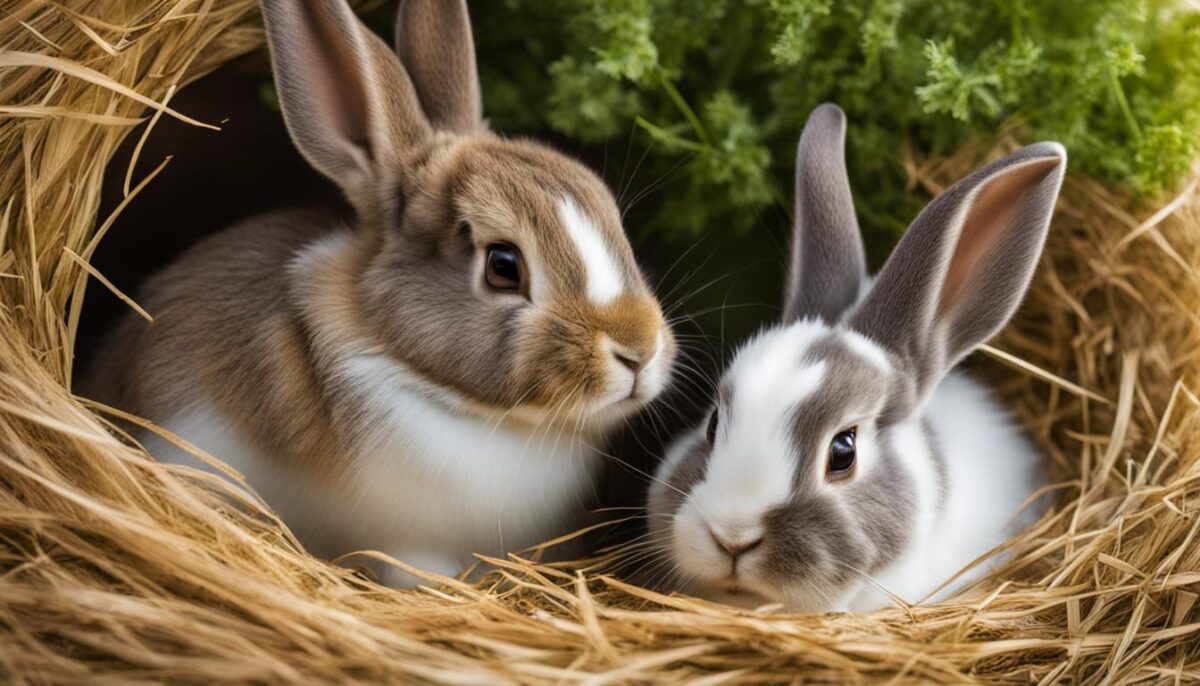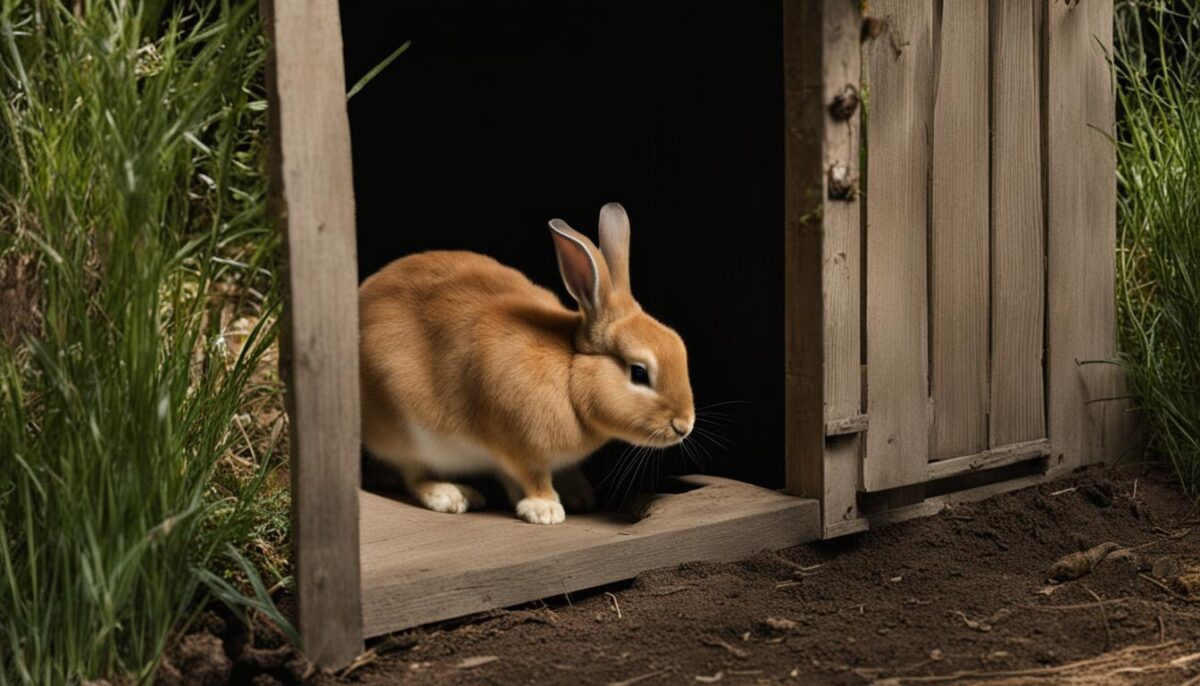Rabbits are fascinating creatures with unique behaviors that often leave their owners intrigued. One common behavior that many rabbit owners encounter is thumping. But why do rabbits thump in their hutch? To understand this behavior, we need to delve into the world of rabbit communication and behavior.
Thumping is a form of communication for rabbits, similar to a dog’s bark or a meerkat’s warning screech. When rabbits feel frightened or threatened, they use the noise of their feet hitting the ground to alert other rabbits of potential danger. This behavior serves as a warning signal and helps to keep the rabbit community safe. However, thumping can also be a way for rabbits to express annoyance or demand attention from their owners. Understanding the reasons behind this behavior is essential for providing the best care for our furry companions.
Key Takeaways:
- Rabbits thump as a form of communication and to warn other rabbits of potential danger.
- Thumping can also be a way for rabbits to express annoyance or demand attention.
- Understanding the reasons behind rabbit thumping is crucial for ensuring their well-being.
- Rabbits may thump in response to loud noises, unfamiliar scents, sudden movements, or the presence of strangers or other animals.
- Creating a secure environment and providing hiding spaces can help rabbits feel more secure and reduce thumping behavior.
The Reasons Behind Rabbit Thumping
Rabbits engage in thumping behavior for various reasons, which can be attributed to their unique way of communicating. Thumping serves as a means to convey messages and express their emotions. By understanding the reasons behind rabbit thumping, owners can better interpret their rabbits’ behaviors and ensure their well-being.
One of the primary reasons rabbits thump is fear or a perceived threat. If a rabbit feels scared or threatened, it will thump its hind legs on the ground to alert other rabbits and signal potential dangers. This behavior has evolved as a survival mechanism to warn others and promote collective safety.
“Thumping is a form of communication that rabbits use to warn others of potential danger,” says Dr. Jane Adams, a veterinarian specializing in small mammal behavior. “It’s important for owners to recognize this behavior and respond accordingly to ensure the rabbit feels safe.”
Another reason for rabbit thumping is annoyance or a desire for attention. If a rabbit is frustrated or wants something, it may resort to thumping as a way to demand the owner’s attention. This behavior is often accompanied by other signs of dissatisfaction, such as digging or biting on objects.
The Meaning Behind Rabbit Thumping
Interpreting rabbit thumping requires careful observation and understanding of the specific context. While fear and annoyance are common triggers, it’s essential to consider other factors such as the rabbit’s environment and past experiences. By observing their body language and other accompanying behaviors, owners can gain insight into the meaning behind rabbit thumping and respond accordingly.
It’s important to note that rabbit thumping should not be ignored. Thumping can be indicative of stress or discomfort, and long-term exposure to stress can negatively impact a rabbit’s overall health and well-being. Therefore, it is crucial for owners to address the underlying causes of thumping and create a safe, secure, and stress-free environment for their rabbits.
| Reasons Behind Rabbit Thumping | Meaning |
|---|---|
| Fear or perceived threat | Warning signal to other rabbits, potential danger |
| Annoyance or demand for attention | Expression of frustration or desire for owner’s attention |
Factors that Trigger Rabbit Thumping
Rabbits can be easily startled or unsettled by various factors in their environment, leading to their instinctive thumping behavior. Understanding these triggers can help rabbit owners offer a more comfortable living space for their furry companions and minimize stress levels. Here are some common factors that can trigger rabbit thumping:
Loud Noises:
Rabbits have sensitive hearing, and sudden loud noises such as fireworks, thunderstorms, or construction sounds can startle them, leading to thumping. Even everyday noises like vacuum cleaners or slamming doors can trigger their natural prey instincts and cause them to respond with thumping.
Unfamiliar Scents:
Rabbits rely heavily on their sense of smell to navigate their surroundings and can be sensitive to new or strong odors. An unfamiliar scent, like a new cleaning product or perfume, can unsettle them and result in thumping as a warning to other rabbits or animals in their vicinity.
Sudden Movements:
Rabbits are creatures of habit and can get easily startled by sudden movements around them. This can include a person reaching towards them too quickly or a sudden change in their environment, such as furniture being rearranged. These unexpected movements can trigger their instinctive thumping behavior.
Presence of Strangers or Other Animals:
Rabbits are naturally cautious creatures and may thump when they sense the presence of unfamiliar humans or other animals. This behavior serves as a warning to other rabbits and can indicate a sense of unease or potential danger.
It is important for rabbit owners to be aware of these triggers and create a calm and secure environment for their rabbits. By minimizing or managing these factors, owners can help their rabbits feel more at ease and reduce their thumping behavior.

Understanding Rabbits’ Sensitivity to their Environment
Rabbits are incredibly sensitive creatures, and their behavior can be influenced by various stimuli in their environment. Some rabbits may have a naturally high-strung disposition, making them more prone to thumping in response to perceived threats. Others may have specific triggers based on past experiences. It’s crucial for rabbit owners to understand their individual rabbit’s sensitivity and identify potential stressors to create a more comfortable living environment.
One common trigger for rabbit thumping is loud noises. Rabbits have sensitive hearing and can become easily frightened by sudden and unexpected sounds. They may thump to alert others of potential danger or to express their own fear. Other triggers can include unfamiliar scents, sudden movements, or the presence of strangers or other animals. Paying attention to your rabbit’s behavior and surroundings can help you pinpoint the specific triggers that cause them to thump.
When it comes to interpreting rabbit behavior, it’s important to remember that thumping is just one form of communication. Rabbits have a complex language of their own, primarily expressed through body language rather than vocalization. Observing their posture, ear position, and overall behavior can provide valuable insights into their well-being and emotional state. By being attentive and responsive to your rabbit’s needs, you can create a nurturing and stress-free environment for them.
Table: Common Triggers for Rabbit Thumping
| Trigger | Description |
|---|---|
| Loud Noises | Rabbits can be easily frightened by sudden and unexpected sounds, such as thunderstorms or loud vehicles passing by. |
| Unfamiliar Scents | Rabbits have a keen sense of smell and may become startled by unfamiliar scents, such as new cleaning products or perfumes. |
| Sudden Movements | Rapid or unexpected movements can startle rabbits and cause them to thump as a way to communicate their fear or unease. |
| Presence of Strangers or Other Animals | Rabbits are territorial animals and may feel threatened by the presence of unfamiliar humans or animals in their surroundings. |
Understanding why rabbits thump in their hutch and being aware of their sensitivity to the environment can help rabbit owners provide the necessary care and support. By minimizing potential stressors and creating a secure and nurturing space, you can help your rabbit feel safe and happy in their surroundings.
The Importance of Addressing Rabbit Thumping
Rabbit thumping is a form of communication and should not be ignored by owners. Long-term stress caused by frequent thumping can negatively affect a rabbit’s welfare and even lead to health issues. It is crucial for owners to identify the reasons behind their rabbit’s thumping and take appropriate actions to address the underlying causes. This may involve removing or minimizing triggers, creating a safe and secure environment, or seeking professional advice from a veterinarian or animal behaviorist.
Rabbits use thumping as a way to express their emotions and needs. It’s important to understand that thumping is not just a random behavior but a signal that something is bothering your rabbit. Whether it’s fear, annoyance, or a demand for attention, addressing the underlying cause is essential for your rabbit’s well-being. Ignoring thumping can lead to increased stress levels, which can have a detrimental effect on their overall health.
To address rabbit thumping, it’s important to observe your rabbit’s behavior and environment. If you notice that certain noises, scents, or movements trigger thumping, try to minimize their exposure to these stimuli. Providing them with a calm and secure environment can help alleviate their anxiety. Additionally, spending quality time with your rabbit, offering them mental and physical stimulation, and ensuring they have a proper diet and living space can contribute to their overall happiness and reduce thumping behavior.
| Addressing Rabbit Thumping | Key Points |
|---|---|
| Identify triggers | Observe your rabbit’s behavior and environment to identify potential triggers for thumping. |
| Create a safe environment | Minimize exposure to triggers, provide hiding spaces, and ensure a calm and secure living space for your rabbit. |
| Seek professional advice | If thumping persists or becomes excessive, consult with a veterinarian or animal behaviorist for guidance. |
| Provide mental and physical stimulation | Enrich your rabbit’s environment with toys, tunnels, and activities to keep them mentally and physically engaged. |
Tips to Help Rabbits Feel More Secure
Creating a secure and comfortable environment is crucial for rabbits’ well-being and can help reduce their thumping behavior. Here are some tips to help rabbits feel more secure:
1. Provide Hiding Spaces
Rabbits feel safer when they have hiding spots to retreat to. You can provide cardboard boxes or purpose-built hides where your rabbit can feel secure and relax. These hiding spaces should be easily accessible and large enough for your rabbit to comfortably fit inside.
2. Use Tunnels for Essential Areas
Creating tunnels that lead to your rabbit’s essential areas, such as food, water, and litter, can help them move around while feeling safe. Tunnels provide a sense of security and allow rabbits to navigate their environment without feeling exposed.
3. Desensitize Your Rabbit to Triggers
If your rabbit is particularly sensitive to certain triggers, such as loud noises or sudden movements, you can desensitize them through gradual exposure and positive reinforcement. Start by exposing your rabbit to the trigger at a low intensity and reward them with treats and praise for remaining calm. Gradually increase the intensity of the trigger over time while continuing to provide positive reinforcement.
By implementing these tips, you can help create a secure and stress-free environment for your rabbit, reducing their thumping behavior and promoting their overall well-being.
Rabbit Hutch Thumping Causes: Understanding Rabbit Behavior and Communication Signals
Rabbits thump in their hutch for various reasons, and understanding their behavior and communication signals can help rabbit owners address these causes effectively. Thumping is a common behavior among rabbits, serving as a way for them to communicate and signal potential threats or discomfort. By interpreting rabbit behavior and recognizing the triggers behind thumping, owners can create a safer and more secure environment for their furry companions.
Rabbit Hutch Thumping Triggers
Rabbits can thump in response to different stimuli that they find alarming or unsettling. Common triggers include loud noises, unfamiliar scents, sudden movements, or the presence of strangers or other animals. For example, rabbits may thump when they hear a car passing by, or when they detect a new smell in their surroundings. Understanding these triggers can help owners identify potential stressors and take appropriate measures to minimize their impact.
While some stressful situations may be unavoidable, such as occasional loud noises or disruptions, there are steps that can be taken to handle them. Creating physical barriers or adjusting the rabbit’s environment, such as closing curtains or moving them away from windows, can help reduce their exposure to stressful stimuli. This can help minimize the impact of unavoidable stressors on their well-being.
Providing Comfort and Support
Aside from minimizing stressors, owners can also provide additional support to help their rabbits feel more secure. This can include creating hiding spaces using cardboard boxes or purpose-built hides, as well as providing tunnels that lead to essential areas like food, water, and litter boxes. These hiding spots and tunnels give rabbits a sense of security and control over their environment, helping them feel more at ease.
Additionally, bonding rabbits with a compatible partner can provide them with companionship and comfort. Having a bonded partner can help rabbits feel more secure in stressful situations, as they can rely on their companion for support. However, introducing a new rabbit should be done carefully and gradually, with guidance from a veterinarian or animal behaviorist to ensure a successful and harmonious bond.
The Role of Bonded Partners in Rabbit Comfort
Rabbits are social animals and thrive when they have a bonded partner. The presence of a companion can greatly contribute to their overall sense of security and well-being. When rabbits feel stressed or fearful, having a bonded partner can provide them with a comforting presence, reducing their anxiety levels and helping them navigate through challenging situations.
The bond between two rabbits goes beyond just companionship. It creates a sense of belonging and establishes a hierarchy within their social structure. When one rabbit is feeling anxious or on high alert, the presence of their bonded partner can help them feel reassured and safe. They can take cues from each other’s behavior and use their body language to communicate messages of comfort and support.
Having a bonded partner can be particularly beneficial during stressful events, such as car rides or visits to the veterinarian. These situations can be very unsettling for rabbits, but the presence of their bonded partner can help alleviate their fear and provide a sense of security. They can rely on each other for emotional support and navigate through these experiences together.
If your rabbit is frequently thumping, it may be a sign that they are experiencing heightened levels of stress or fear. Consider whether they would benefit from a bonded partner to provide them with the comfort and companionship they need. Introducing a new rabbit into their environment should be done gradually and under supervision to ensure a successful bond. Consulting with a veterinarian or animal behaviorist can provide guidance on the bonding process and ensure a positive experience for both rabbits.

Table: Benefits of Bonded Rabbit Partnerships
| Benefit | Description |
|---|---|
| Reduced Stress | The presence of a bonded partner can help reduce stress levels in rabbits, providing them with a sense of security and comfort in challenging situations. |
| Enhanced Emotional Well-being | Bonded rabbits establish a strong emotional connection, creating a supportive environment that promotes emotional well-being. |
| Improved Communication | Rabbits in bonded partnerships can communicate through body language, providing comfort and reassurance to each other. |
| Shared Experiences | Having a bonded partner allows rabbits to share experiences and navigate through life’s challenges together, fostering a sense of companionship. |
Rabbit Behavior: Interpreting Communication Signals
Rabbits have a unique way of communicating their needs, feelings, and potential stressors through their behavior. As a responsible rabbit owner, it is crucial to understand and interpret these communication signals to ensure the well-being of your furry companion.
“Rabbit communication is a complex language expressed primarily through body language rather than vocalization.”
By observing your rabbit’s posture, ear position, and overall behavior, you can gain valuable insights into their emotional state. For example, a relaxed rabbit with ears positioned forward indicates a content and comfortable state, while a rabbit with ears flattened or thumping signifies fear, threat, or annoyance.
Common Rabbit Communication Signals:
- Thumping: A loud noise made by rabbits using their hind legs, typically as a warning sign when they feel scared or threatened.
- Ear Movements: Ears positioned forward indicate curiosity or contentment, while flattened ears can indicate fear or aggression.
- Body Posture: A relaxed and elongated body posture signifies comfort, while a hunched or tense body indicates stress or fear.
- Vocalizations: While rabbits are generally quiet animals, they can make soft purring sounds when they are relaxed or content.
Understanding these communication signals helps you identify potential stressors and address them effectively. By creating a secure and safe environment, minimizing triggers, and providing companionship if needed, you can help your rabbit feel more comfortable and reduce their stress levels.
| Communication Signal | Meaning |
|---|---|
| Thumping | Warning sign or expression of annoyance |
| Ear Movements | Indication of curiosity, fear, or aggression |
| Body Posture | Relaxation, comfort, or stress/fear |
| Vocalizations | Purring sounds indicate relaxation and contentment |
Remember, each rabbit is unique, and their communication signals may vary. Regular observation, interaction, and consultation with a veterinarian or animal behaviorist can help you develop a deeper understanding of your rabbit’s behavior and ensure their overall well-being.
The Complexity of Rabbit Body Language
Rabbits have a unique language of their own, primarily expressed through their body language rather than vocalization. Understanding their body language is key to interpreting their emotions, needs, and potential stressors. By observing their posture, ear position, and overall behavior, you can gain valuable insights into their well-being and emotional state.
Some common body language signals in rabbits include:
- Ear position: Rabbits will often have their ears forward when they are curious or alert. However, if their ears are flattened against their back, it indicates fear or aggression.
- Posture: A relaxed rabbit will have a loose, stretched-out body. On the other hand, a tense and hunched posture may indicate stress or discomfort.
- Thumping: As discussed in previous sections, thumping is a clear communication signal used by rabbits to warn others of potential danger.

Table: Common Rabbit Behaviors and Their Meanings
| Behavior | Meaning |
|---|---|
| Thumping | Warning or expression of annoyance |
| Ear flopping | Relaxation or contentment |
| Teeth grinding (purring) | Pleasure or satisfaction |
| Circling | Social interaction or territorial marking |
| Chin rubbing | Territorial marking or exploration |
Understanding rabbit behavior is a continuous learning process. Each rabbit has its own unique personality and communication style, so it’s important to spend quality time observing and interacting with them. By doing so, rabbit owners can provide the best possible care and create a harmonious bond with their beloved pets.
Conclusion
In conclusion, rabbit thumping is a significant form of communication for rabbits. By understanding the meaning behind thumping and interpreting rabbit behavior, owners can effectively respond to their rabbits’ needs and ensure their well-being. Thumping serves as a warning signal to other rabbits, expressing fear, annoyance, or the need for attention.
It is crucial for rabbit owners to pay attention to their rabbits’ surroundings and identify potential triggers for thumping behavior. Loud noises, unfamiliar scents, sudden movements, and the presence of strangers or other animals can all be factors that trigger thumping. Creating a safe and secure environment for rabbits and minimizing stressors can help reduce thumping episodes.
Regular veterinary check-ups are essential for monitoring a rabbit’s health and behavior. If thumping becomes persistent or if any concerning behavior is observed, it is important to consult with a veterinarian. By observing and understanding rabbit body language, owners can better anticipate their needs and provide appropriate care, ensuring a happy and stress-free life for their furry companions.
FAQ
Why do rabbits thump in their hutch?
Rabbits thump in their hutch as a form of communication. It is usually a response to a frightening situation and serves as a warning to other rabbits.
What are the reasons behind rabbit thumping?
Rabbits thump for various reasons, including fear, annoyance, or to communicate a specific message.
What factors can trigger rabbit thumping?
Rabbits can thump at anything that scares or unsettles them, such as loud noises, unfamiliar scents, or sudden movements.
Why are rabbits sensitive to their environment?
Rabbits are highly sensitive animals and can react to various stimuli in their environment. Some rabbits are naturally more anxious or highly-strung, which makes them more prone to thumping in response to perceived threats.
Why is it important to address rabbit thumping?
Long-term stress caused by frequent thumping can negatively affect a rabbit’s welfare and even lead to health issues. It is crucial for owners to identify the reasons behind their rabbit’s thumping and take appropriate actions to address the underlying causes.
What are some tips to help rabbits feel more secure?
Providing rabbits with hiding spaces, desensitizing them to certain triggers, and creating a safe and secure environment are some tips to help rabbits feel more secure.
How should unavoidable stressful situations be handled?
Minimizing the impact of stressful situations by creating physical barriers or adjusting the environment can help reduce a rabbit’s stress levels.
What is the role of bonded partners in rabbit comfort?
Having a bonded partner can help rabbits feel more secure in stressful situations and provide support and comfort.
Why are regular veterinary check-ups important for rabbits?
Regular veterinary check-ups are essential for rabbits’ overall health and well-being. They can help identify any underlying medical conditions and provide guidance on managing stress and behavior.
How can rabbit body language be understood?
Observing and understanding a rabbit’s body language, including posture, ear position, and overall behavior, can provide valuable insights into their well-being and emotional state.
Why is it important to observe rabbit behavior?
By observing and interacting with rabbits, owners can better anticipate their needs, identify stress triggers, and create a supportive environment.


